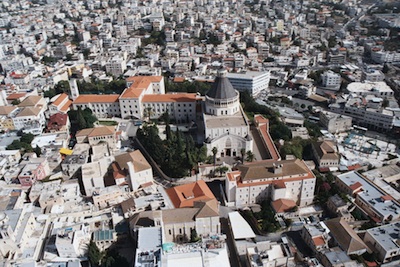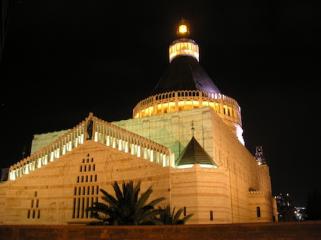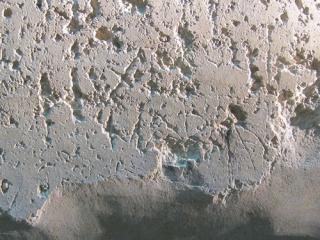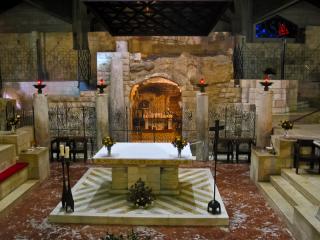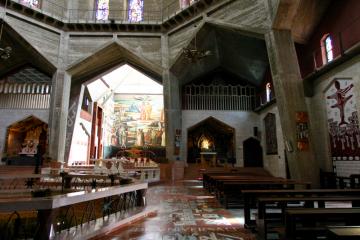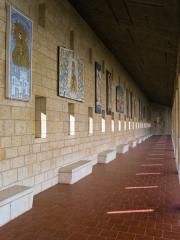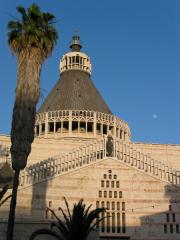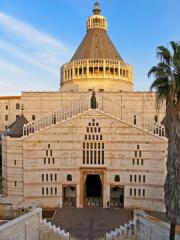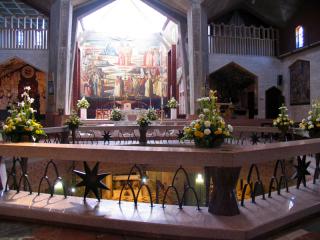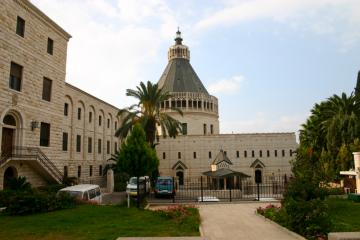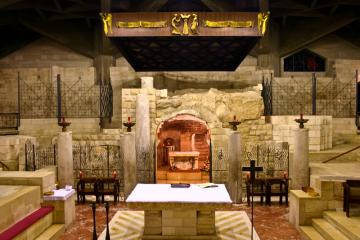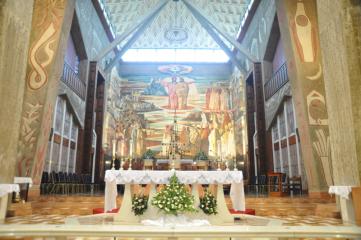The excavations on Franciscan property
Brother Benedict Vlaminck was the first to survey the subsoil around the holy grotto. He published the results of his discoveries in 1900 in its "A Report of the Recent Excavations and Explorations conducted at the Sanctuary of Nazareth." In 1982 he discovered a second grotto with frescoes, then named after Conon, and located to the west of the venerated one and with Byzantine remains of mosaic floors. On this occasion it was the first find on the site of the Crusader church, which held Byzantine remains.
In 1889 and later between 1907 and 1909, the investigations were continued by Prosper Viaud and the results were quickly published in 1910, enhanced with beautiful illustrations in the volume “Nazareth et ses deux églises de l'Annonciation et de Saint-Joseph”. The discoveries had an immediate effect thanks to the unearthing of the mosaic with the crown and the monogram of Christ, together with the famous crusader capitals depicting the stories of the Apostles, found hidden inside a grotto beneath the floor of the convent’s parlour. It seems certain that the capitals, perhaps never used, were hidden at the end of the crusader period in order to protect them from being pillaged or destroyed by the Muslims.
Other excavations were carried out during the construction of the new Franciscan convent in 1930, but the diaries with the annotations were lost during the second world war.
The project for the construction of the new Basilica of the Annunciation, inaugurated in 1969, was the occasion to begin more thorough and extensive research on the history of the village and the ancient remains. The archaeological excavations were directed by father Bellarmino Bagatti, one of the founding fathers of the archaeological tradition of the Studium Biblicum Franciscanum, who had an expert understanding of the village’s antiquity.
In March 1955, the structures of the Franciscan Church, built in 1730 and extended in 1877, and the old convent and schools were knocked down. The space that was located to the north of the holy grotto, once finally free from structures was explored between April and June of the same year with the help of more than 120 local workers who digging on a daily basis closely watched by father Bagatti and his collaborator father Gaetano Pierri, cleaned up an area of around 90 x 60 metres. The investigations resulted above all in an understanding the village, its characteristic materials and development over time.

The work allowed for the exploration of the area to the east, south and north of the Grotto and shed light on the remains of the crusader and Byzantine churches and the ancient village.
As concerns the crusader Church, aside from the north wall and some other structures already well documented in the past, the apses and the exterior walls were completely unearthed, the cemetery that developed to the east was discovered and at the same time, many parts of granite columns and sculpted blocks that were part of the rich sanctuary’s decoration were uncovered.
The following sections of the Byzantine complex were investigated: the Church- with the apses, the three aisles and the vestry – the remains of the mosaic floors of the areas to the south of the church – and finally, the space reserved for the atrium where a water cistern was also unearthed.
The excavation of the village, of which the remains can still be visited today inside the archaeological area at the side of the Basilica, uncovering a system of natural and artificial grottos that were an integral part of the dwellings. Different storage bins for grain as well as cisterns for water were found. The latter contained ceramic, providing evidence that the site was used from the iron age up until modern day. A series of tombs dating back to the Middle Bronze Age were also discovered.
During the construction of the new sanctuary, it became necessary to better conserve the Byzantine mosaics. As a result, they were removed and positioned on a new base. Consequently, the opportunity to also investigate the areas beneath the mosaics arose. To the great surprise of father Bagatti and his collaborators, the remains of a more ancient pre-Byzantine building were brought to light, with clear and multiple signs of Christian veneration.
Overall, there were three main results:
- the discovery of the village of Nazareth in the southern area including the house of the venerated Grotto confirming the existence of the village at the time of Jesus;
- a greater understanding of the structures and of the organisation of the spaces of the two Byzantine and crusader churches;
- the extraordinary discovery of the remains of the first place of worship built on the venerated Grotto, testimony to an interrupted conservation of the memory of Mary’s holy place, from the first Christian centuries up until today.
P.Bagatti described his discoveries in the two volumes dedicated to “Gli scavi di Nazareth” (“The Nazareth excavations”) from the origins to the seventh century and from the twelfth century to today. These were dated and stamped respectively in 1967 and 1984 and followed by a publication translated into English.
The pre-Byzantine building
In 1959, during the construction of the new Basilica, the Byzantine mosaics were removed in order to better preserved and relocated at the end of the work. On removing them, a surprising discovery was made: beneath the floor of the church and convent, various blocks of stone with painted and inscribed plaster belonging to an older religious building were found.
In particular, beneath the mosaic of the central aisle, right in the place where the small crosses and the monogram of Christ are depicted, a square-shaped basin cut in the rock with sides which are about two metres long and 1.6 metres deep and steps along the southern side was discovered. At the bottom of the basin, in the north eastern corner there is a circular well with a further hollow in the corner. In the wall plaster there are traces of the incisions made when the mortar was still fresh and interpreted by P. Testa as depictions of stairways (allusions to the "cosmic stairways"), crosses and boats.
The basin seems to have been closed and filled with various pieces of stone, ceramic dating back to the end of the 4th century and, in the upper layer, lots of fragments of white and coloured plaster bearing traces of graffiti written in the Syriac language. This basin is similar in shape to that of the crypt of Saint Joseph, but is not covered in mosaic. P. Bagatti, who initially thought it was designed for collecting wine, later decided that it was instead used for religious purposes. The similarity with that of Saint Joseph, led him to suppose that it was a baptism bath for Jewish-Christian initiation. Not all experts share this interpretation. More specifically, Taylor believes both the basins – of Saint Joseph and the Annunciation – more likely to be used for the village’s agricultural activities, for collecting pressed grapes for making wine.
Various building materials were found beneath the southern aisle and in the convent area. These were used to raise the level of the floor: pieces of painted and inscribed plaster, ceramics, illegible coins, fragments of roof tiles and pieces of marble slabs to cover the walls or floors. About seventy large architectural pieces were also discovered, including plaster, were also found that must have belonged to a demolished religious building: capitals, drums and bases of various columns made from local stone known as "nari", blocks which belonged to the arches of an aisle (double arch imposts), various worked cornices, door jambs and squared stones.
The ancient village of Nazareth
The excavations carried out since 1955 by P. Bellarmino Bagatti have brought to light part of the area occupied by the ancient village, today included in the modern Nazareth. In particular, it was investigated the space that was occupied, until 1930, by the Franciscan convent, built in turn over the bishop's palace of the Crusader era.
The town descended along the slope of the hill, in the space that today separates the two Franciscan sanctuaries of St. Joseph in the north and the Annunciation in the south. The village was surrounded to the north by a kind of natural amphitheater, formed by hills that reach the five hundred meters of altitude, while in the east and west it was bordered by valleys that descended towards the plain of Esdrelon. The steep side of the hill, on the east side, descended precipitously: today the eastern valley is still recognizable along Via Paolo VI, which connects the lower part of the city to the modern Nazareth Illit. The modern development of the city instead covered the western valley, which was to end in the area of the current souk, where there was also a source of water.
The northern, southern and western limits of the village have been identified thanks to the discovery of tombs dated from the Middle Bronze to the Byzantine period. The abundant presence of natural water sources, which facilitated the life of the village, is testified by the "source of Mary" located north of the evangelical village, which today flows from the rock enclosed in the Greek church of St. Gabriel and which is called from the local "Ain Sitti Maryam".
The excavations conducted by P. Bellarmino Bagatti, have highlighted the remains of an agricultural village frequented from the Iron Age II (900-600 BC), gradually structured around simple houses that exploited the underground caves, excavated in the tender limestone rock. They were part of the houses and were used for housework and as a shelter for animals. While the real houses, in masonry, were located on the surface or leaning against the caves.
Because of the different buildings built gradually in the area, there remained very few traces of the ancient houses and when P. Bagatti began the investigation he took the decision to immediately excavate up to the natural rock. The collection of archaeological data has therefore often been limited to traces found in the rock.
The agricultural character of the village is evidenced mainly by the numerous silos, pear-shaped holes with a circular entrance tapped by a stone, dug into the soft rocky limestone. The silos had to store the collected grains and even reached two meters deep. They were ingeniously arranged on top of each other, in several levels, and connected by tunnels that facilitated the storage of goods and the aeration of the grains. Along with the silos were found the cisterns that collected rainwater. Near for oil and grapes flanked by oil and wine cells, they were part of a production complex of which the stone millstones were also found.
By studying the connections between the silos and the arrangement of the water tanks it was possible to trace the hypothetical limits between the various properties: these had to be self-sufficient from the water point of view. Eugenio Alliata was able to intercept at least four distinct areas, with caves and silos connected, which were supposed to belong to four different dwellings.
The venerated cave, located on the southern side of the village, clearly belonged to one of these complexes that, at a certain point, also developed a productive area, equipped with an oil mill, of which a press with a squeezing collection tank remained. of wine or oil cells.
As already highlighted, the caves dug in the rock, like that of the Annunciation, were underground rooms of the houses. These consisted of one or more masonry rooms, perhaps also furnished with upper floors. The caves were used as warehouses in which to store the goods inside the silos, or as stalls for the animals; but they could also be used for various domestic activities and for hosting small ovens.
An excellent example of semi-rupestrian dwellings can be visited in the archaeological area next to the Basilica. We observe a cave with a small room in front of which the first row of stones remains. In this cave, by digging under the floor of the convent's parlor, Fr. Viaud discovered the five splendid Crusader capitals now kept in the museum. In the cave there is still an oven built in the north-west corner, and you can see some silos in the floor. Handles carved into the rock and a manger, refer to the use of the cave as a stable, at least for a certain period.
The history of the human occupation of Nazareth is summarized by some groups of ceramic types exhibited in the museum: they go from the 2nd millennium BC. at 1500 d.C.
The vases of the Middle Bronze I and II (200
The Byzantine Church
According to the tradition of Epiphanius ("Panarion" XXX.II.10) it was the Count Joseph of Tiberias, a Jew converted at the time of Constantine, who asked to be able to build the first Christian church in the village of Nazareth, by the first half of the 4th century. There is no concrete evidence on the Count's success in his attempt to build the church, but the hypothesis is thought to be probable. Towards 383, the pilgrim Egeria saw a "grand and splendid grotto" where the Virgin Mary was said to have lived, with an altar inside and a garden where the Lord stayed after his return from Egypt.
In the testimonial accounts of the early centuries there is the tendency of people not to speak of places of worship that do not belong to their own tradition. An example are Saint Jerome and Epiphanius In the specific case of Nazareth, there is the theory that there had always been a place of prayer in the house of Mary, but this had not been found by the authors of noble stock, as it was conserved by the Jewish-Christian community. In fact Jerome, writing of his pilgrimage in the company of Paul and Eustoch, does not speak of churches in Nazareth, but only mentions the village. It is thus deduced that Nazareth was one of the places visited by pilgrims from the very early centuries.
A direct mention of the church was only to come in 570, with the visit of the Anonymous Pilgrim of Piacenza ("Itinerarium", V). He observed the village, but also the "House of Mary" converted into a church, as well as the synagogue officiated by the Jews.
Following the Arab conquest of 638 there came the description of the pilgrim Arculfus, who told the Abbot Adamnan of having seen two large churches in Nazareth: “one, where our Saviour was suckled”, the other “which is known to have been built over the house where Gabriel the Archangel spoke to Mary”.
Of these two churches only that of the Annunciation remained, as can be assumed from the testimony of Willibald in 724-26, which only speaks of the Annunciation, now at the mercy of the Muslims.
The last pre-crusade testimony is by the Arab historian al Mas’udi, in 943: he writes of having visited Nazareth and found “a church held in great veneration by Christians and where there are stone sarcophagus with bones of the dead, from which seeps a syrup-like ointment, used by the Christians to anoint themselves in prayer”. These were probably sepulchres placed in the church and highly venerated by believers.
Of the Byzantine church, the remains of which, surviving ruin, left space to the new ecclesiastical building built by the crusaders, consist in just a few walls on the foundation level, and sections of mosaic flooring. The digs of last century enabled an outline of the building layout: this consisted in a church oriented east to west, preceded by an atrium and flanked to the south by a monastery. Overall, these buildings covered an area of 48 metres in length from west to east, and 27 metres from north to south.
The Byzantine architects integrated natural environments into the church, made up of Grottos: this was not a new feature, in fact many Byzantine churches, such as those of Tabga or Getsemani, housed venerated rocks, or such as the church of Nativity, built around a series of grottos.
The church was made of three naves, the central one closed off by a semicircular apse. The grottos, at least two in number, were incorporated in the northern nave and were on a lower level: this is why the lateral grotto was accessed from the central nave by a stairway. There was a rectangular room at the end of the southern nave, interpreted as being a sacristy. The church exterior was 19.5 metres long and, including the atrium 39.6 metres long. The central nave was 8 metres wide.
The atrium leading to the church covered a large cistern still in use until 1960, and commonly known as the "cistern of the Virgin". Of the monastery there remains a row of rooms, while the area closest
to the church was irretrievably damaged by the crusade buildings.
The most well-known aspect of the Byzantine church is the mosaic flooring, present both on the area of the grottos and in the naves and monastery. Comparisons with a number of mosaics, oriented to the north, rather than the east, leads us to suppose that not all were made for the Byzantine church but were probably the flooring of an older building oriented towards the grottos.
The mosaic of the central nave, already noted during the digs of Father Prospero Viaud, is oriented to the north. It depicts the monogram of Christ on a white background, enclosed in a crown tied at the bottom with two tapes; in the lower section there are a number of crosses, including a great cross, with four small crosses alongside. It is worth noting that tiles of different sizes were used to complete this mosaic.
The mosaic on entrance to the grottos was unearthed by Brother Benedict Vlaminck, while conducting investigations outside the walls of the 18th century crypt. Along the west side of the Grotto of the Annunciation, he found the remains of another frescoed grotto, which had a mosaic on the entrance bearing the inscription in Greek, citing the deacon Conon of Jerusalem, as donor of the mosaic, under the same name of Conon of Nazareth, relative of Jesus and martyr of the 2nd century. This mosaic is also oriented to the north, like the mosaic of the central nave, and depicts a carpet with squares joined by diagonal lines interspersed with diamonds; crosses and other geometrical patters can be seen inside the squares. The inscription is found in a corner of the entrance to the grotto, known as the "Grotto of Conon". In this small grotto, there is a floor with a white background, featuring a larger square joined with diagonal lines to a smaller central square with diamonds alongside, the monogram of Christ is also found here.
The mosaics laid specifically for the Byzantine church are those oriented to the east, which can be seen in the southern lateral nave: there are also traces of the geometrical cornices that framed the entire nave. The oldest mosaic was later covered by a second. The primitive mosaic was with a fish scale frame containing a small flower, to then be replaced by a more elaborate cornice featuring a pattern of circles and diamonds. The elaborate details of this second mosaic distinguish it from all others found.
At the eastern end of the same nave, in the sacristy, there are traces of another mosaic, in the style of the that in the central nave and the grotto of Conon, with squares and diamonds on a white background.
The other areas of the monastery also had mosaic floors, conserved above all in two adjacent rooms, one small and one larger and rectangular. The first features a cornice of intertwined cords; the second shows a cross of flowering branches that form diamonds and an intertwined cornice surmounted by circles, limited to the eastern part of the room. In this larger room, towards the centre, the remains of a clay jug were also found, embedded in the floor.
The most precious feature of these mosaics is the presence of unmistakeably Christian symbols, such as the simple, great and monogram crosses. This element, typical of the Byzantine religious buildings, contributes to establishing the "terminus ad quem", i.e. the time frame within which the flooring was laid, as a decree by Theodosius II, in 427 (Cod.Just. i.8.I), forbade the representation of crosses in flooring.
The closest comparison for the mosaics of Nazareth is found in the church of Shavei Zion of the 5th century, which as well as featuring the cross conserve evident similarities in the geometrical patterns.
The Byzantine church also held a number of architectural fragments found in the digs: for example five pulvinos in white stone decorated at the sides with crosses, probably originally located between Corinthian style capitals and the start of the nave arch. Six high column bases were also unearthed, which probably belonged to the older building. Various other fragments belonged to the balustrade that divided the nave from the presbytery: the small square pillars supported the panels in marble decorated with grape vines, crosses, crowns and inscriptions in Greek, of which some fragments were conserved.
According to Father Bagatti, when considering both the stylistic and architectural features, the Byzantine church can be dated within a vast period, ranging from the 5th century to the 7th-8th century.
Various grottos were dug into the rocky hillside descending from north to south, and were used as part of the home or for production systems. Among these, only two were part of the Shrine: one larger version, venerated for the Annunciation, and a smaller and irregular one known as the Grotto of Conon. The grottos underwent several changes above all in the Middle Ages, when the grotto of the Annunciation was expanded and that of the Conon was partially demolished and set underground. However, it is quite plausible that from the very start their form would have been changed on insertion within the place of worship.
Today the grotto of the Annunciation features an irregular layout, running 5.5 metres from north to south and 6.14 metres from west to east, with a small apse in the eastern wall. Of the Byzantine era, there are remains on the northern side of layers of plaster, which in all likelihood covered the entire bare rock face of the Grotto. Another interesting feature, in the second layer, is a number of traces of graffiti.
The second grotto, known as the grotto of Conon, may once have been used as a memorial space with a raised bench. This area was set underground in the Middle Ages. On the eastern wall there are a remarkable six layers of overlaid plaster. The oldest plaster can now be seen, representing a strip with flowered plants and crown, and a painted inscription in Greek. According to Bagatti and Testa the painted inscription names Valeria “servant to our Lord Christ”, who made “a memory for the light”, in other words had the grotto decorated with the representation of a flowered Heaven in memory of a martyr, perhaps the same Conon of Nazareth. There are other examples of graffiti in the plaster, with a series of names and entreaties to Christ; a coin dates this oldest layer of plaster to the second half of the 4th century.
Crusader Nazareth
With the capture of Jerusalem by the Crusaders (1099), the Principality of Galilee was entrusted to Tancred of Hauteville, who established the capital in Tiberias. The Principality always remained a vassal of the Kingdom of Jerusalem, entrusted to families originating from the north of France, and specifically, from 1120, to the Bures dynasty from the Île-de-France.
A Latin bishop named Bernardo was already active in Nazareth in 1109-1110, head of a community of regular canons who carried out liturgical service and the welcoming of pilgrims. Under Bishop William (1125-1129), Bernardo’s successor, Nazareth became metropolitan archdiocese with jurisdiction over all Galilee and with two suffragan seats led by the abbot of Mount Tabor and the bishop of Tiberias.
The Grotto of the Annunciation was incorporated into a new solemn construction and was restored to being a destination site for numerous pilgrimages. The first testimony, written about the Crusader basilica, dates back to 1106-1107 and is by the Russian pilgrim Daniel, who tells of having seen a large and magnificent church erected in the centre of the village, which kept the grotto in which the angel declared the annunciation to Mary.
According to the testimony, the work for the construction of this impressive basilica began very early, probably thanks to the rich donations that Tancred made at the church of Nazareth. The basilica, served by regular canons , was next to the bishop palace and contained a guest area for welcoming pilgrims as well as a well-stocked library. Moreover, the archbishop had six knights and around one hundred and fifty sergeants at his command. The archdiocese became so rich that it could boast properties from the Levantine to southern Italy, a country that in 1172 had sixteen churches controlled by Nazareth.
The cathedral of Nazareth, in all its splendour, as proven by the archaeological remains, would most definitely have reflected the wealth and prestige of the archbishop. Besides the Annunciation, the Crusaders built at least two other churches, that of Saint Joseph and also of Saint Gabriel that included the well in which according to the Infancy Gospel of James, Mary met the Angel before receiving the annunciation in the dwelling.
Although there is no record of the amount of damage that the town suffered in the catastrophic earthquake that hit Syria and the city of Tyre hard on 29th June 1170, it is certain that Nazareth was subjected to the Muslim looting that followed the earthquake. The Nazarenes and religious people were captured and incarcerated. In December of the same year, spurred on by an appeal of Letard, Archbishop of Nazareth, Pope Alexander III wrote to the French Christians to ask for help for the town. Father Bagatti, who directed the excavations of Nazareth, believed that the church was also damaged in the earthquake. According to the archaeologist, the seism acts as a gap between the period of construction and that of decoration of the building, made possible by the contribution of France. The link between Nazareth and France must have been very close given that the architectural and sculptural style with which the cathedral was lavishly decorated is that of 12th century France, particularly of Bourgogne, Ile-de-France, the Viennois and Provence.
The Greek pilgrim Giovanni Focas of 1177 (or perhaps 1185) describes a grotto of the Annunciation that is different with respect to that of the first century and splendidly decorated. The indications let us believe that the construction and part of the decoration of the cathedral was already finished by the end of the century and before the Saracen invasions. In 1183, the inhabitants of Nazareth were besieged for the first time by the Saladin troops which were camped out on the surrounding hills, forcing the entire village to seek refuge within the strong walls of the church.
The church served as a fortress and protection even following the defeat of the "Horns of Hattin" in July 1187 when the inhabitants were besieged by the Emir of Saladin, Muzafar al-Din Kukburi. The siege led to the conquest of Nazareth, the killing of the inhabitants and the profanation of the holy building that, however, remained undamaged.
For around forty years, the city and its archdiocese remained in Muslim hands and only a series of truces and grants allowed the religious people to begin celebrating in the basilica again and welcome the pilgrims.
Nazareth and the road that connected to Acre officially returned under Christian control in January 1229 as a result of the agreement between Frederick II and the Sultan al-Malik al Kamil; the French control of the town was confirmed again in 1241, but it seems that the archbishop did not return there before 1250.
The last rich donation of sacerdotal furniture, paraments and vestments to the cathedral was given by Louis IX, King of France, who undertook a pilgrimage to Nazareth in March 1251.
Finally, in April 1263, the town was besieged by one of the Emirs of the Sultan Baibars: the village was plundered and the impressive Crusader basilica was destroyed forever. Spared from destruction, until 1730 the Grotto of the Annunciation remained the only place in the area still accessible to the pilgrims, who however had to pay a fee to the Muslim guards.
The first Franciscan church of the eighteenth century

In eighteenth-century Nazareth, Christian communities lived in a time of greater tranquillity. Proof of this is the fact that in 1730 the Pasha granted the construction of a new church on the Sacred Grotto, to be implemented in six months, the time required for his pilgrimage to Mecca. On 15 October 1730, Custos Pietro da Luri consecrated the new church, which finally was able to accommodate the local Latin community now growing. On the opening day, in fact, more than a hundred Catholics received Confirmation.
The growth of the community would push the Custody, in 1877, to extend the length of the church, thanks to the support of Father Cipriano of Treviso, Commissioner of the Holy Land. The building lay in a north-south direction, with the Grotto of the Annunciation incorporated in the crypt under the chancel and preceded by a short hall. In the contemporary chronicles of the Holy Land, the church was described as the most beautiful owned by the Latin Church in the East. In 1742, Father Elzear Horn made a number of drawings clearly showing the layout of the Grotto under the chancel, reachable by a staircase. In the anteroom to the Grotto, there was the Chapel of the Angel, with groined vault ceilings supported by the four granite columns still visible today. In the vestibule, on the left, there was an altar dedicated to San Gabriele. A wooden altar was located in back of the cave, richly decorated with a painting of the Annunciation and, under the altar, the exact point of the Incarnation, shown by the following silver writing, “Verbo Caro hic factum est.” All eighteenth-century depictions show the two broken and unbroken columns, which for centuries have indicated the place where the Angel Gabriel and the Virgin stood during the Annunciation. The place was connected by an ancient tunnel to the cave called "Cucina di Maria" and the Franciscan monastery.
The upper church had an altar on either side, one dedicated to San Francesco and the other to Sant’Antonio da Padua, and two side altars in the apse, dedicated to San Giuseppe, husband of Mary and to Sant’Anna, mother of the Virgin.
The new shrine
Already at the end of the First World War the Custodia proposed, to Pope Pius IX, the idea of building a more worthy shrine, in the place of the Annunciation. Many years later, in 1954 the propitious opportunity arose: the first centenary of the proclamation of the dogma of the Immaculate Conception. To celebrate this anniversary, padre Custode Giacinto Faccio decided to start the work, which involved demolishing all the 18th century structures and conducting archaeological investigations of the ancient ruins.
The renowned architect Antonio Barluzzi, who had designed major shrines for the Custodia, such as the Getsemani, Tabor and Dominus Flevit, was the first to be assigned for the design of the new shrine. An article with drawings of his designs was published in the magazine of Holy Land in 1954. The design envisaged a great church with central layout, covered by a cupola and flanked by four bell towers; it was designed, as was the Church of the Holy Sepulchre, with the worshipped grotto at the centre.
The rediscovery of the ancient village and the archaeological remains of the various buildings of worship that followed over the centuries, revealed an age-old and uninterrupted Marian veneration, and thus became an indispensable element to be considered in the design of the new shrine. Along these lines was also the Holy See, from which came the invitation to best conserve the remains of the ancient village and various churches. This recommendation led the Custodia to promote a new project, this time assigned to the Italian architect Giovanni Muzio, on proposal by Custodian Father Alfredo Polidori, who valued the experience of Muzio in the design of religious buildings, in particular for the Friars Minor, for whom he had designed the church of Santa Maria Mediatrice in Rome, with the annexed Curia Generalizia.
The needs to be met were manifold: to build a new Marian shrine that could welcome millions of pilgrims from all over the world; to conserve as far as possible the crusade, Byzantine and pre-Byzantine remains in view, as testimony to the long-standing worship of the location; to overcome difficult topographical conditions due to the steep slopes of the hills; to create a practical location, easily managed even by a limited number of religious figures and which could also be host to the parish community activities of Nazareth.
The architect became so impassioned with the project that he wavered his fee.
He designed a church founded on the crusade walls and divided onto two levels, so that on the lower level followers could stay and pray in front of the grotto of the Incarnation of the Word, in a simple but capacious area, while a large upper church would be used to celebrate the glorification of Mary over the centuries and the continents. For this reason, he chose to decorate the walls depicting the various Marian events that have occurred across the various regions of the world. Muzio also thought of a large central oeil-de-boeuf window open above the Grotto, so that the two churches could merge into one, crowned by a polygonal cupola in the shape of an inverted crown of flowers terminating in a skylight, with the function of indicating, like a star, the Holy Place from afar.
With the approval of the Holy See, the works started and proceeded uninterrupted. The Custodia met the onerous costs of the work also thanks to the generous response of many donors who, through the pages of the magazine “The Holy Land” and the precious help of the Commissaries of the Holy Land, were kept up-to-date with the phases of construction.
Works to prepare the site started in 1959 and the agreement with the contracted firm was signed in September of 1960. In 1964, Pope Paul VI, during his pilgrimage to the Holy Land, visited the new Shrine under construction.
On Sunday 23 March 1969, after eight years of work, the shrine was finally consecrated in the presence of Cardinal Gabriele Maria Garrone - at the time Prefect of the sacred Congregation for Catholic Education -, of the Latin Patriarch of Jerusalem S.B. Monsignor Gori, of the Minister General of the Order of Franciscan Friars Father Costantino Koser, of the Custos of the Holy Land Very Reverend P. Alfonso Calabrese. The custos who alternated during the planning and production of the work were P. Giacinto Faccio, P. Angelo Lazzeri, P. Alfredo Polidori, P. Lino Cappiello and P. Alfonso Calabrese.
The Franciscans in Nazareth
Boniface of Ragusa, who was twice Custos of the Holy Land, wrote in 1567 that about twenty years earlier the friars were in Nazareth, where they guarded the Church of the Annunciation. At one point, due to unrest in the country, they had to take refuge in Jerusalem leaving the keys to a local Christian who, "until now guards the house, opens and closes the church and holds two lamps lit with oil, which the father Custos gives him."
With a firman – a Sultan’s decree – obtained from the father superior of the Holy Land on 15th June 1546 the Franciscans were granted permission to restore their church in Nazareth. Evidently, it was the church of the Annunciation built by the Crusaders and destroyed, among whose ruins the worship in the Grotto continued. The church, however, was not restored because of the continuous attacks against Christians that caused the friars to leave.
The Franciscan presence in Nazareth was made official starting in 1620. In that year, the Custos Thomas Obicini da Novara obtained donation of the venerated Grotto by Druze Emir of Sidon, Fakhr ad-Din II. With the cave now in the hands of the Franciscans, father Jacques de Vendôme, a brave and energetic friar of French nationality, remained to guard the Grotto along with two other brothers who joined him from Jerusalem. He built some temporary cells on top of the Crusader ruins and a small room adjacent to the Grotto, used to celebrate functions.
Starting with the killing of the emir in 1635, the friars lost their protection and the Christians of Nazareth were targeted by the Turks in the two following centuries: the Grotto was repeatedly sacked, stripped of furniture and damaged while the friars were beaten, jailed and even killed.
In the 17th and 18th centuries, both the abandonment of the convent of Nazareth and the forced retreat to the Franciscan hospice of Acco or to Jerusalem were repeatedly required. In the 17th century in particular, extortion and looting by the governor of Safed brought the friars to seek justice repeatedly in front of the Imperial court in Istanbul, both to have their goods back and also to have the extortion of money cease along with the restoration of the rule of law in the country. Despite this, their tenacity brought them to open the first parish school in 1645 and to give hospitality to pilgrims in the hospice they set up between the simple cells of their small convent. Even pilgrimages - processions related to religious holidays - despite being hampered, departed from Nazareth to the nearby places of the gospel memories such as Cana and Tiberias.
In 1697, given the continuing difficulties, the Franciscans thought of a solution to better cope with the continuous instability. For this reason they "rented" the village of Nazareth and, over time, three other villages not very far from it (Yaffia, Mugeidel and Kneifes). To keep the rent, the friars had to pay a hefty fee. This practice kept constant until 1770, when they gave up because of the unsustainable taxation. In practice, the father Custos of Nazareth took on the task of judicial and civil servant, collecting fees for the Pasha of Saida and the governor of Acco. It was an office comparable to that of Emir, in other words, Lord of the place.
During the 19th century, the Ottoman Empire began to suffer from internal nationalist movements that were agitating the Arab world. Out of that came a more liberal and reformist Sultan Abdülmecid I, who granted greater openness also towards the right of religious expression. For example, in 1867 the friars were able to open a novitiate for the training of young Franciscans in Nazareth, which was closed in 1940. It was a century of growth for everyone: the Latins, which in 1848 counted 600 faithful, had become double that by the end of the century. Social and parish-linked activities grew as well: the opening of the first school for girls dates back to 1842, joining the two others that the Custody was inaugurating in Jerusalem and Bethlehem. A hospice for pilgrims was built in 1837, which was destroyed by an earthquake and a flood. The current Casa Nova, built in front of the basilica, dates back to 1896. In addition to hosting famous guests such as Napoleon Bonaparte, the Casa Nova also welcomed many Palestinian refugees from the 1948 Arab-Israeli war.
Today the Franciscans in Nazareth have a parish community of 5,000 faithful gathered around the Sanctuary of the Annunciation. The Franciscan Terra Sancta College occupies a large building connected to the convent and has about 800 Christian and Muslim students, thus fostering religious integration. Other social activities are turned to the elderly in the nursing home and the disabled who benefit from having their own centre. Additionally, the Custody built some homes to support the persons in need.
